UK’s housing market remains subdued, amidst uncertainty surrounding Brexit
House prices in UK are still rising, at least in nominal terms (i.e. not adjusted for inflation). But uncertainty over Brexit and the upcoming general elections are now clouding the housing market’s prospects.

The average house price in the UK rose by a meagre 0.3% to £216,805 (US$ 276,968) during the year to Q3 2019, according to Nationwide - a slowdown from last year’s 2.1% growth. It was the lowest annual increase since Q1 2013. When adjusted for inflation, house prices actually fell by 1.4% y-o-y in Q3 2019.
London registered the biggest house price decline of 1.7% (-3.4% inflation-adjusted) during the year to Q3 2019 - the ninth consecutive quarter of price falls in the capital city, with double-digit declines for some top-end central London properties. Despite these declines, London’s prices are still more than 50% above 2007 peak levels.
The Outer Metropolitan Area around London and the Outer South East also recorded house price falls of 1.5% and 0.6%, respectively (-3.2% and -2.4% in inflation-adjusted terms).
The highest price rise was in Northern Ireland, with house prices rising by 3.4% during the year to Q3 2019 (1.5% inflation-adjusted). It was followed by Wales (2.9%), North West (2.5%), West Midlands (2.1%), North (2%) and East Anglia (1.7%). Regions with weaker price rises included the Scotland (0.8%), South West (0.5%), East Midlands (0.4%) and Yorkshire and Humberside (0.1%).
Demand continues to fall. In the first three quarters of 2019, residential property transactions completed fell by 1.1% from a year earlier, following annual declines of 2.3% in 2018 and 1.2% in 2017.
“We remain unchanged from our view that activity levels and price growth will remain subdued while the UK navigates political and economic uncertainty,” said Russell Galley, managing director at Halifax.
However the chronic housing shortage will prevent a significant drop in prices, according to the Royal Institution of Chartered Surveyors (RICS). Property transactions are expected to fall by about 5% in 2019 from a year earlier.
“October has been full of political twists and turns, and with Brexit uncertainty ongoing, many buyers and sellers have adopted a ‘wait and see’ approach,” said Jerald Solis of Experience Invest.
The UK economy is expected to expand by 1.3% this year, down from 1.4% in 2018 and the slowest pace since 2012, according to the Bank of England.
Housing boom and bust in UK
UK property prices saw huge rises from 1996 to 2007:
- Prices in London rose 289.1% (228.1% in real terms).
- Prices in Northern Ireland rose by 393.2% from Q3 1996 to Q3 2007 (315.9% in real terms), the highest rise among UK regions.
- Price increases in other regions ranged from 187.9% (142.8% in real terms) for Scotland, to 245.5% (191.3% real) for the Outer Metropolitan Area.
- The national index rose 240.9% (187.5% in real terms) over the same period (all figures from Nationwide).
In early 2007 interest rates were raised, and lending conditions tightened. House price falls accelerated in H2-2008, due to the global financial meltdown. The biggest falls occurred in Northern Ireland where house prices fell by 39.2% (-41.9% real). London house prices fell by 19.8% (-23.3% in real terms).
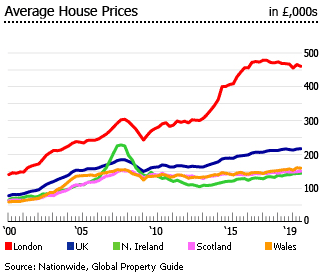
The housing market started to recover in 2013, with nationwide house prices rising by 22.8% (14% real) from 2013 to 2018. London had the biggest price growth of 35.3% (25.7% real) over the past five years.
The UK’s and particularly London’s house price rises have been fuelled by four factors:
- Strong immigration and population growth, especially in London.
- Interest rates at record lows, with a large expansion of the money supply through "quantitative easing".
- The City of London continues to boom.
- Construction activity remains weak (though this is less true of London).
London prices are now declining
The gap between London and the rest of UK is now declining, amidst continued house price falls in the capital city. In Q3 2019, the average London home is worth 130% more than the average home elsewhere in the UK – a huge gap, but the lowest since Q4 2014. The average difference in price was £260,154 (US$ 332,346), according to Nationwide.
The gap between London prices and the rest of the UK peaked in Q1 2017, when home prices in the capital were 154% higher than the rest of the country, with an average price difference of £290,140 (US$ 370,654).
Despite falling since Q2 2017, the average house price in London remains 52% higher than at the peak in 2007. Several other regions have higher property values than their 2007 peak prices:
- Outer Metropolitan London is 38.5% up on 2007.
- Outer South East is 29.1% up on 2007.
- East Anglia is up by 26.5%.
- South West is up by 20.6%.
- East Midlands is up by 19.3%.
- West Midlands is up by 17.8%.
- North West is up by 4.7%.
- Wales is up by 2.8%.
- Yorkshire and Humberside is up by 2.6%
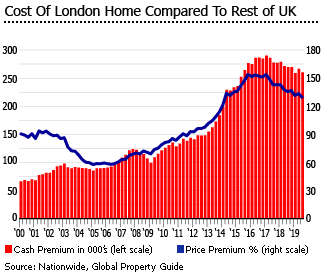
The remaining regions remain lower than their 2007 peak values. Northern Ireland had the weakest performance, with prices still 36.8% lower than at the 2007 peak. Home prices in the North, and in Scotland, remain 5.2% and 1.4% below their peak.
Falling demand
In 2018, residential property transactions in the UK fell by 2.3%, to around 1,191,460, following a 1.2% decline in 2017. In the first three quarters of 2019, residential property transactions fell further by 1.1% from the same period last year.
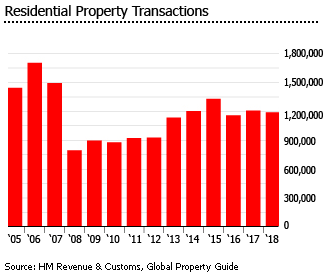
Weak housebuilding activity
The UK’s per capita housebuilding rate is low by international standards, and failed to respond sufficiently to rising house prices during the boom, due to planning constraints.
There were about 200,000 home completions in the UK last year. However at least 250,000 new homes must be built annually to match population growth, to replace the ageing housing stock and the accumulated backlog, says the Town and Country Planning Association (TCPA).
Homebuilding in the UK stagnated at an average of 186,000 new units annually between 1991 and 2003, and from 2004 onwards barely exceeded 200,000 annually (222,940 in 2007).
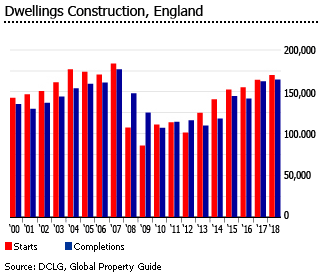
A reform of the planning system, relying on local initiatives, is under way to speed the system up and expand the housing supply. However, the government’s budget constraints are putting all this under threat.
The government is targeting around 240,000 new dwellings annually until 2020. However, the target seems unrealistic, since output over the past 20 years has been around 150,000 dwellings annually.
Raising housing supply and other reforms
To address supply shortages, the government spelt out housing market reforms in a housing white paper published in February 2017. Measures include:
- Councils will be required to make up-to-date plans to meet housing demand;
- The maximum time between planning permission and the start of building construction is to be lowered from three to two years;
- Small and medium-sized developers are to be boosted through a £3 billion (US$ 3.94 billion) home building fund;
- Upward extension of buildings in urban areas is to be encouraged;
- Standard tenancies are to be made more ‘family-friendly’ by raising the tenancy length to three years or more in new build homes;
- Letting agents’ fees are banned.
In 2014 a Starter Homes policy was announced to address the affordable housing crisis. The Starter Homes policy aims at households with combined incomes below £80,000 (US$ 102,200), or £90,000 (US$ 114,975) in London. But a recent review by the National Audit Office (November 5, 2019) showed that building has not yet commenced, despite £250 million being spent to buy land for affordable properties, partly because enabling legislation was never passed.
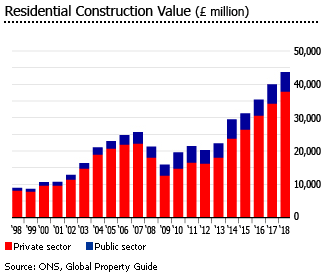
Starter homes must cost a minimum of 20% less than the market value, and maximum price after the discount will be £450,000 (US$ 574,875) in London and £250,000 (US$ 319,375) elsewhere. Buyers of starter homes will need a mortgage. If the property is resold within 15 years, some of or all of the discount must be repaid.
Key rate kept at 0.75%; mortgage rates falling
The Bank of England (BoE) raised its key rate by 25 basis points in August 2018 to 0.75%, the highest level since February 2009.
Despite this, mortgage rates continue to fall. In October 2019, average interest rates for types of mortgages with 75% loan to value (LTV) were:
- 2-year fixed rate mortgages (FRMs): 1.55%, down from 1.8% a year ago
- 3-year FRMs: 1.63%, down from 1.85% a year ago
- 5-year FRMs: 1.74%, down from 2.06% a year earlier
- 10-year FRMs: 2.64%, slightly down from 2.72% a year earlier
- Standard variable rate mortgages: 4.29%, down from 4.45% a year ago
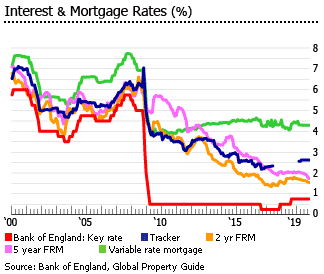
Mortgage market softens
UK’s mortgage market is softening, as buyers become more cautious amidst economic and political uncertainties.
In August 2019:
- New loans to first-time buyers fell by 2.1% y-o-y to 33,300, based on the latest Mortgage Trends report released by UK Finance
- New loans to home movers fell 8.2% y-o-y to 33,610
- Remortgages with additional borrowing fell by 5.7% y-o-y to 17,720
- Mortgages for buy-to-let house purchases fell by 3.3% y-o-y to 5,900
Yet gross mortgage lending was still up by about 3.2% in the first nine months of 2019 from the previous year to £198.3 billion (US$253.3 billion), compared to 1.4% growth last year, according to the BoE. In the first nine months of 2019, the value of loan approvals for house purchase rose by 4.9%.
The UK’s mortgage market has been weaker since the 2007 financial crisis. Cash transactions have been more resilient. "This is because cash buyers were less impacted by the tightening in credit conditions," said Nationwide.
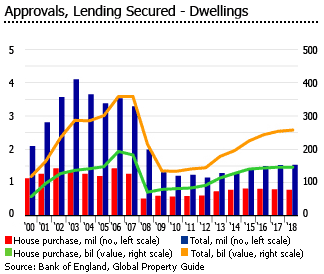
In 2018, the top five lenders accounted for more than 64% of outstanding mortgage loans (Lloyds Banking Group, 20.4%; Nationwide BS, 13%; Santander UK, 11.2%; Royal Bank of Scotland, 9.8%; and Barclays, 9.7%), according to UK Finance.
FCA relaxes mortgage prisoner rules
New rules to allow lenders to use different affordability assessment for "mortgage prisoners" were introduced in October 2019 by the Financial Conduct Authority (FCA). “Mortgage prisoners” are borrowers unable to qualify for a new deal with a different provider because they do not meet certain criteria, leaving them trapped with providers that charge high interest rates.
Inactive lenders and unregulated firms, which are not authorized for mortgage lending, are also required to inform borrowers of the rule changes and suggest them that they could get a better deal by remortgaging to another lender.
About half a million mortgage borrowers in the UK are under inactive or unregulated lenders. Of those, around 140,000 borrowers would save money if they were able to remortgage to another lender with lower interest rates.
“Mortgage prisoners are often stuck on more expensive mortgages,” said Christopher Woolard of FCA. “We are removing barriers to switching in our rules and we would like to see firms make changes to their own processes quickly in order that customers can benefit as soon as possible.”
Challenges facing the UK housing market
Aside from the sluggish growth of household incomes and the ongoing political uncertainty, three other factors are also slowing the UK housing market:
[1] Effects of greatly increased stamp duties
UK Stamp Duty rates have been sharply ramped up in recent years. In April 2016, Stamp Duty rates on buy-to-let transactions increased very significantly - greatly dampening activity.
In April 2010 a new 5% Stamp Duty rate was introduced on homes over £1 million. In March 2012, 6% Stamp Duty was introduced on homes over £2 million.
In December 2014 stamp duty structure rates were raised significantly on each band, and a new system was introduced - instead of being payable on the entire price, Stamp Duty is now calculated by cumulatively adding the rate on each bracket. So the first £125,000 of a property purchase is completely free of tax, the bracket between £125,000 and £250,000 attracts Stamp Duty at 2%. etc. At the higher ranges, the rates have since been very high: 10% Stamp Duty is payable on the band between £925,000 and £1,500,000, and 12% is payable above £1,500,000.
Present stamp duty rates are:
- Up to £125,000 - 0%.
- Over £125,000 to £250,000 - 2%.
- Over £250,000 to £925,000 - 5%.
- Over £925,000 to £1,500,000 - 10%.
- Over £1,500,000 - 12%
On April 1, 2016, a new stamp duty surcharge of 3% on top of the current Stamp Duty Land Tax (SDLT) became effective. The higher rates apply to purchases of additional residential properties in England, Wales, Northern Ireland, and Scotland (separately announced in the Scottish Government’s Budget).
A slight change in stamp duties was implemented since November 22, 2017, which was only applicable for first-time buyers. First-time buyers are now free of tax on the first £300,000 on properties worth up to £500,000, then 5% on the remaining portion between £300,001 and £500,000. However, if the property exceeds £500,000 then the standard rates apply on the entire property price.
Table of Rates for Buy-to-let Properties
- Up to £40,000 - 0%
- From £40,001 to £125,000 - 3%
- From £125,001 to £250,000 - 5%
- From £250,001 to £925,000 - 8%
- From £925,001 to £1,500,000 - 13%
- Over £1,500,000 - 15%
Example calculations of stamp duty rates:
Home price - stamp duty payable
- £250,000 - £8,800
- £350,000 - £16,800
- £450,000 - £24,800
- £500,000 - £28,800
- £750,000 - £48,800
- £1,000,000 - £72,550
- £2,000,000 - £212,550
Source: StampDutyRates.co.uk
The general effect is to significantly increase levels of Stamp Duty payable on buy-to-lets. On a £300,000 flat bought as a residence, the buyer will pay £5,000, but when bought as buy-to-let, as much as £14,000 is now payable (4.6%). Big difference! Charges mount further on large properties. Want to spend £1,000,000 for a normal-sized house to convert it into 5 flats? Stamp duty is £73,750, or 7.4% of the purchase price. (See effective Stamp Duty rates at different price-bands here: www.stampdutyrates.co.uk and Buy-to-let calculator).
It seems likely that many potential landlords will balk at these high Stamp Duty rates.
This is in addition to changes made in the Summer 2015 budget where landlords only receive mortgage interest relief at the basic rate of income tax at 20%, a tax change which starts from 2017.
Another change for buy-to-let investors is the introduction of a 30-day payment window. Starting April 6, 2020, landlords will have to pay Capital Gains Tax (CGT) within 30 days of selling a property. Currently, any CGT due gets paid at the end of the current tax year.
These moves, as well as the "Annual Tax on Enveloped Dwellings", a separate tax on companies purchasing houses in UK, have had a significant impact on the willingness of potential buy-to-let landlords to invest. According to a recent study conducted by Hamptons International, the share of British homes owned by overseas landlords has more than halved in eight years, falling from 14.4% in 2010 to just 5.8% in 2018. The number of overseas landlords in London shrank to 10.5% in 2018, from 26% in 2010.
Recently, the government unveiled a new plan to introduce a Stamp Duty Land Tax (SDLT) surcharge of 1% on purchases of residential properties in England and Northern Ireland by non-UK resident buyers in a future Finance Bill.
This proposed plan seems to only add pressure on the market. "Further taxes on international buyers sends out a conflicting message about post-Brexit Britain being ‘open’ to the world," says Cluttons LLP’s head of research Faisal Durrani. Durrani noted that if the new surcharge is confirmed, residential forecasts should be revisited "with a view to making further downward revisions".
Despite all this, the fall in Sterling has encouraged some extra international buy-to-let buying in the UK, particularly in London. “The proportion of homes let by overseas based landlords rose for the first time in more than nine years,” said Hamptons International’s analyst Aneisha Beveridge. “Sterling’s depreciation has made investment property in Great Britain more attractive to international investors. The average home cost 23% or £53,065 less than in 2014 for a US dollar buyer, solely due to the currency changes.”
As such, the proportion of overseas landlords has increased to 11% in the first ten months of 2019, up from 7% a year ago – the first growth since Hamptons started collecting data in 2010. But this is at the expense of British landlords who are being driven away from the market. On a regional basis, London and the East of England recorded the biggest rise, both having increased by 8% y-o-y in Jan-Oct 2019, to reach 18% and 14%, respectively.
[2] The Panama Papers and anti-money laundering moves
Following the Panama Papers leak of April 2016 which suggested that a large amount of money laundering was feeding into London’s property market, former prime minister Cameron announced in July 2016 that the UK would publish information on property owned by foreign companies, and that a consultation would be launched on how to improve transparency.
“My message to fraudsters is: London is not the place to stash your dirty cash” said Cameron. He announced that foreign firms that own property in the UK would have to declare their assets publicly, and be on a new register if they hold UK property or want to compete for government contracts.
More than 100,000 UK property titles are registered to overseas companies, with more than 36,000 properties in the capital owned by offshore firms. In total around 2,800 companies set up by Mossack Fonseca are connected to more than 6,000 title deeds on British property - mostly in London - worth at least £7 billion.
“The crackdown on foreign ownership and property investments could possibly freeze the already slowing market,” says Stirling Ackroyd Legal CEO Emon Ahmed. In London, the Battersea Power Station Development company held back some Frank Gehry and Foster + Partners designed apartments after its CEO confessed that the market had become ‘quite challenging’.
Peter Wetherell, chief executive of Mayfair firm Wetherell, said potential buyers may decide to rent instead of buying. “This latest Panama issue uncovers where wealthy people are putting or investing their money, so it going public is a massive loss of privacy for the people concerned,” said Wetherell.
On June 26, 2017, the EU’s 4th Money Laundering Directive became UK Law. The directive, according to the legal and professional services firm Gordon Dadds, may lead to a longer buying process, higher costs, and a doubling of real estate agents’ administrative burdens. The buying process could slow by up to 186 days, with estate agents required to carry out further diligence in verifying property buyers and sellers. Workloads are expected to double, say Gordon Dadds, as all policies will need to be tailored to every client.
“This is going to create substantial challenges for the property sector especially given the final version of the directive has only been made public today which has left no time for banks, estate agents and the lending sectors among others to update their policies and processes alongside training staff on the new regime,” according to Gordon Dadds partner Alex Ktorides. “Some agents have in excess of 100 branches and have received no prior time to implement the new processes in order to comply. For many smaller estate agents and surveyors this will be the first time they will have carried out checks on both the buyers and sellers and they are going to have to get up to speed with the regime as quickly as possible or risk facing a unannounced visit from the HM Treasury.”
An amendment to the sanctions and anti-money laundering bill backed by Labour MP Margaret Hodge and the Conservative MP Andrew Mitchell, would force Britain’s 14 overseas territories to adopt public company ownership registers by the end of 2020 - including the British Virgin Islands (BVI), which hosts more than half the offshore companies mentioned in the Panama Papers, according to Transparency International.
Aside from that, the Department for Business, Energy and Industrial Strategy (BEIS) announced in July 2018 that the UK will adopt the European Union’s fifth anti-money laundering directive. The directives include the creation of public company registers, and a cross-border database of company and trust owners, among many others.
However despite all these measures, a recent study conducted by Transparency International showed that the use of dirty money remains rampant in various UK institutions, including private schools and interior designers. “Corrupt individuals are now channeling their ill-gotten gains through service industries that fall outside anti-money laundering rules.”
For instance in February 2019, a court froze the HSBC bank accounts of Luca Filat, the son of ex-Moldovan Prime Minister Vladimir Filat, who is currently serving a 9-year sentence for embezzlement. Luca Filat had paid £390,000 upfront to rent a luxury apartment in Knightsbridge, London.
The National Economic Crime Centre estimates the amount of dirty money seeping into the UK at more than £100 billion annually, while Transparency International places a much higher estimate at £325 billion.
In October 2019, the EU proposed the creation of a new central body to crack down on money laundering activities in the region after a series of high-profile scandals exposed its weaknesses in preventing tainted money from flowing through its banks.
[3] Right-to-Buy extended
The UK government has stated its intention to extend Right-to-Buy discounts to 1.3 million housing association tenants in England.
In August 2018, the government announced a pilot scheme of extending right to buy to housing association tenants in the Midlands. The scheme, which costs around £200 million, pledges to replace sold properties with new affordable homes.
Then in September 2019, housing secretary Robert Jenrick unveiled plans to give housing association tenants the right to purchase a share in the equity of their home – starting at 10% and increasing in 1% chunks.
In the Global Property Guide’s view, these policies could increase downward pressure at the lower end of the UK housing market, especially in depressed areas, by giving existing tenants a financial bonanza and extra mobility, by putting their low-end housing on the market.
Help-to-Buy Schemes: Equity loans extended, ISA scrapped
On the other side of the demand / supply scale, the government introduced Help to Buy schemes. Assistance is provided through either an equity loan or a mortgage guarantee.
Through the Help to Buy Equity Loan, the government loans homebuyers up to 20% of the full purchase price of a new-build property, provided that borrowers contribute 5% of the property price as deposit, and secure a mortgage for the remaining 75% of a property. The homebuyer is not allowed to sub-let the property and it must also be his/her only property.
Since its inception in 2013, the Help to Buy Equity Loan has helped over 195,000 households. Over half of new build homes sold last year were backed by Help to Buy.
The Help to Buy ISA has been closed to new savers in favor of a Lifetime ISA, which provides homebuyers an extra 25% free government cash on their savings.
HELP-TO-BUY ISA VS. LIFETIME ISA |
||
| Help-to-Buy ISA | Lifetime ISA | |
| How much can you save? | £2,400 annually (£3,400 in Year 1) | £4,000 annually |
| Can you put lump sums in? | No, need to save monthly | Yes |
| What is the maximum bonus? | £3,000 | £32,000 |
| What is the maximum property price? | £250,000 (£450,000 in London) | £450,000 |
| Who can open it? | First-time buyer aged 16 up | Anyone aged 18-39 |
| Source: The Sun | ||
Rental growth is picking up; a ban on letting agent fees
Rents in Great Britain are picking up, according to Hamptons International. The South East saw the biggest increase in rents, having risen by 3.9% y-o-y in October 2019, followed by East of England with 3.8% increase. The other regions saw minimal rent increases while North of England was the only region to see a decline, of 0.6%.
A new Tenants’ Fees Bill banning letting agent fees came into force in June 1, 2019 for all tenancies signed on or after that date. According to consumer group Citizens Advice some tenants were being charged up to £700 (US$894) worth of fees, with the average tenant paying £337 (US$431).
“We believe these amendments strike a fair balance between improving affordability for tenants whilst ensuring that landlords and agents have the financial security they need,” said the Ministry of Housing, Communities and Local Government.
Slower expansion expected in 2019; Withdrawal Agreement still in limbo
The UK economy grew by 1.4% in 2018 from a year earlier, down from a growth of 1.8% in 2017 and the slowest pace since 2012. Then in Q3 2019, the economy expanded by a minuscule 1% from a year earlier, according to the Office for National Statistics (ONS) - the lowest y-o-y growth in almost a decade.
The UK’s GDP growth per capita figures are also unimpressive. In 2018, GDP growth per capita was 0.8%, according to the International Monetary Fund (IMF).
In general, the UK’s recovery since the recession has been anaemic, at best. In previous recessions, there was above average growth. For instance in 1983 GDP grew by 4.2%, and in 1994 by 3%. This compares to an annual average growth of just 1.9% from 2010 to 2018. The UK’s growth mostly relies on its services sector, according to the ONS.
Recently, the Bank of England slashed its economic growth forecast for 2019 to 1.3%, from its earlier projection of 1.5%.
The UK was originally scheduled to leave the EU on March 29, 2019, two years after Prime Minister Theresa May triggered Article 50 – the formal procedure to leave the EU and start the negotiation process. May stood down as Conservative Party leader in June 2019, and in July Boris Johnson became the new prime minister. The EU has agreed to a further extension until January 31, 2020.
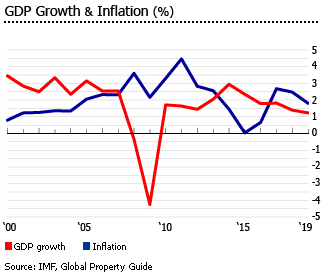
Any deal that the UK strikes with the EU is now heavily dependent on the outcome of the general elections to be held on December 12, 2019. If Johnson’s Conservative Party wins a parliamentary majority, UK will be on track to leave the EU on January 31 and the reduced uncertainty is expected to boost business and investor confidence. However, if no party was to gain a majority, the UK economy is expected to remain in limbo with higher chances of further delays and possibly a second referendum.
In Q2 2019, the UK’s overall unemployment rate was at 3.9%, slightly down from 4% a year earlier, and the lowest level since 1974, according to the ONS.
The UK’s inflation stood 1.7% in September 2019, down from 2.2% a year earlier, amidst a slowdown in transport costs due to the decline in fuel prices.
Sources:
- Investigation into Starter Homes (National Audit Office): https://www.nao.org.uk/report/investigation-into-starter-homes/
- Bank Rate maintained at 0.75% - November 2019 (Bank of England): https://www.bankofengland.co.uk/monetary-policy-summary-and-minutes/2019/november-2019
- None of pledged starter homes built, says watchdog (BBC News): https://www.bbc.com/news/business-50296672
- Mortgage Trends (UK Finance): https://www.ukfinance.org.uk/data-and-research/data/mortgages/lending-trends
- Largest mortgage lenders (UK Finance): https://www.ukfinance.org.uk/data-and-research/data/mortgages/largest-mortgage-lenders
- FCA introduces rules to free ‘mortgage prisoners’ from costly deals (The Herald): https://www.heraldscotland.com/business_hq/17999377.fca-introduces-rules-free-mortgage-prisoners-costly-deals/
- Mortgage prisoners may finally be able to switch to a better deal after the City watchdog relaxes its rules (This is Money): https://www.thisismoney.co.uk/money/mortgageshome/article-7621619/Mortgage-prisoners-finally-able-switch-better-deal.html
- Housing white paper (Ministry of Housing, Communities & Local Government): https://www.gov.uk/government/collections/housing-white-paper
- UK Stamp Duty Rates: https://www.stampdutyrates.co.uk/
- Proportion of overseas based landlords halves since 2010 (Hamptons International): https://www.hamptons.co.uk/news-research/press-releases/august-18-2018/
- Foreign investors snapping up properties while British landlords forced out of market (The Telegraph): https://www.telegraph.co.uk/property/buy-to-let/overseas-investors-back-british-landlords-squeezed-thanks-buy/
- Capital gains tax on property (Which?): https://www.which.co.uk/money/tax/capital-gains-tax/capital-gains-tax-on-property-avuq96u1500f
- London Luxury Homes Face New Hit as U.K. Plans Foreign Buyer Tax (Bloomberg): https://www.bloomberg.com/news/articles/2018-09-30/may-plans-to-hike-u-k-property-tax-for-foreign-home-buyers
- INSIGHT: Stamp Duty Land Tax for U.K. Property—Next Steps (Bloomberg Tax): https://news.bloombergtax.com/daily-tax-report-international/insight-stamp-duty-land-tax-for-u-k-property-next-steps
- Anti-corruption summit: Cameron plans to name foreign property owners (BBC News): https://www.bbc.com/news/business-36272225
- New EU anti-money laundering directive means added burden for estate agents (Property Wire): http://www.propertywire.com/news/uk/new-eu-anti-money-laundering-directive-means-added-burden-estate-agents/
- ´Dirty money´: U-turn as Tories back plans to make tax havens transparent (The Guardian): https://www.theguardian.com/politics/2018/may/01/uk-to-introduce-public-ownership-registers-for-overseas-territories
- UK Adopts EU Anti-Money Laundering Legislation (Organized Crime and Corruption Reporting Project): https://www.occrp.org/en/daily/8363-uk-adopts-eu-anti-money-laundering-legislation
- Dirty money ´targeting UK prestige services´ (BBC News): https://www.bbc.com/news/business-50168247
- EU proposes new anti-money laundering body in wake of scandals (Financial Times): https://www.ft.com/content/d810c676-fb34-11e9-98fd-4d6c20050229
- Housing association tenants in Midlands to be given right to buy (The Guardian): https://www.theguardian.com/society/2018/aug/16/housing-association-tenants-in-midlands-to-be-given-right-to-buy
- Housing association tenants to get ‘shared ownership’ Right to Buy, Jenrick reveals (Inside Housing): https://www.insidehousing.co.uk/news/news/housing-association-tenants-to-get-shared-ownership-right-to-buy-jenrick-reveals-63503
- Help to Buy (Hamptons International): https://www.hamptons.co.uk/publications/market-insight-april-may-2019/market-indicators/
- When do Help to Buy Isas stop and why are they being scrapped? (The Sun): https://www.thesun.co.uk/money/10212593/when-help-to-buy-isa-stop-why-scrapped/
- Overseas landlord numbers up for first time since 2010: Hamptons (Mortgage Strategy): https://www.mortgagestrategy.co.uk/overseas-landlord-numbers-up-for-first-time-since-2010-hamptons/
- Tenant Fees Bill provisions to come into effect June 2019 (National Landlords Association): https://landlords.org.uk/news-campaigns/news/tenant-fees-bill-provisions-come-effect-june-2019
- Letting agent fees banned in Autumn Statement (Financial Times): https://www.ft.com/content/ee2803a6-b0d8-11e6-a37c-f4a01f1b0fa1?mhq5j=e1
- The Economy (Hamptons International): https://www.hamptons.co.uk/publications/market-insight-october-november-2019/economy/
- World Economic Outlook Database (International Monetary Fund): https://www.imf.org/external/pubs/ft/weo/2019/02/weodata/index.aspx
- Unemployment rate (aged 16 and over, seasonally adjusted) (Office for National Statistics): https://www.ons.gov.uk/employmentandlabourmarket/peoplenotinwork/unemployment/timeseries/mgsx/lms
- CPIH Annual Rate 00: All Items 2015=100 (Office for National Statistics): https://www.ons.gov.uk/economy/inflationandpriceindices/timeseries/l55o/mm23
- Brexit: All you need to know about the UK leaving the EU (BBC News): https://www.bbc.com/news/uk-politics-32810887
- Gross Domestic Product: Quarter on Quarter growth: CVM SA % (Office for National Statistics): https://www.ons.gov.uk/economy/grossdomesticproductgdp/timeseries/ihyq/qna
- UK GDP growth likely bounced back in Q3 but more weakness ahead – Forex News Preview (XM): https://www.xm.com/uk-gdp-growth-likely-bounced-back-in-q3-but-more-weakness-ahead-forex-news-preview-112066
- UK growth ´slowest in almost a decade´ (BBC News): https://www.bbc.com/news/business-50373505